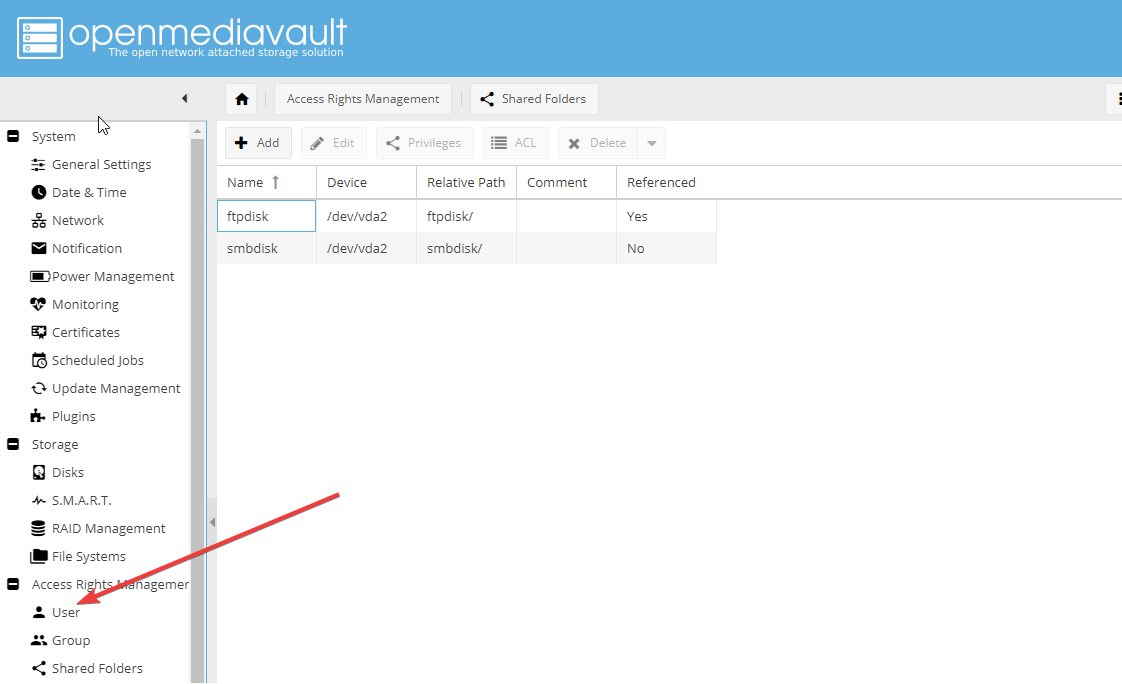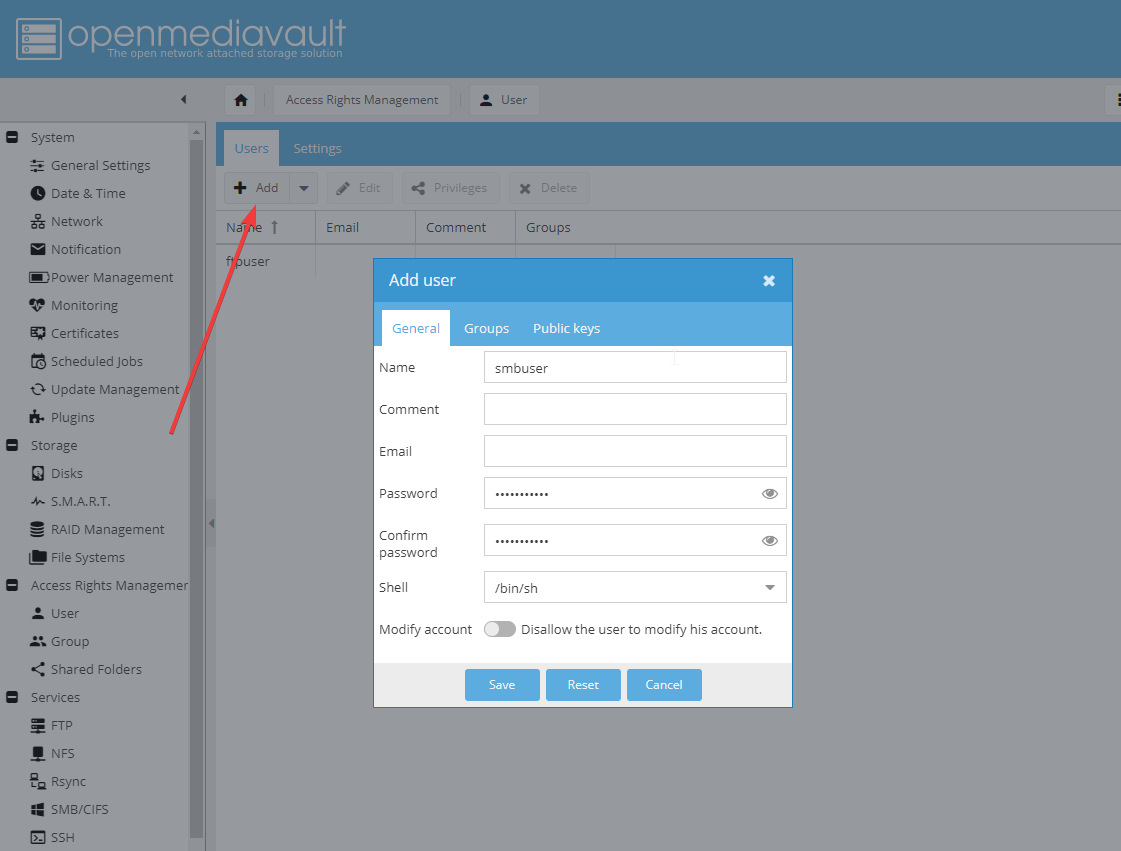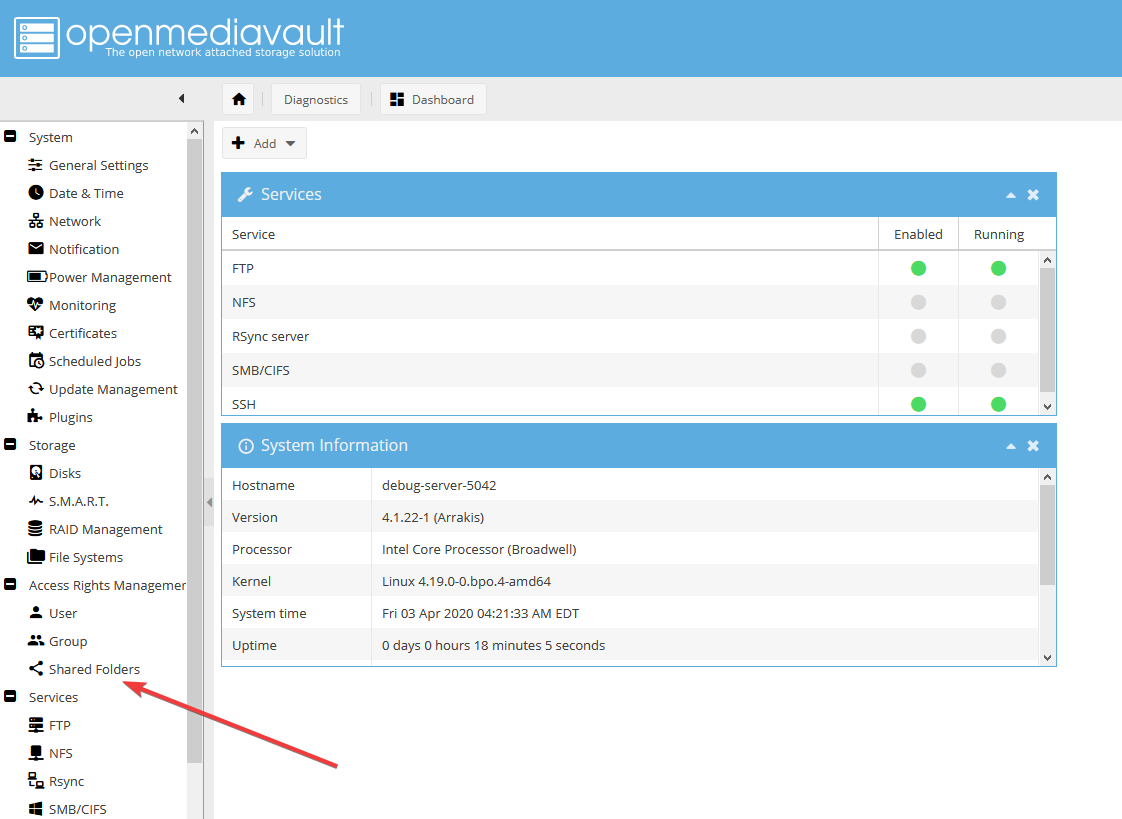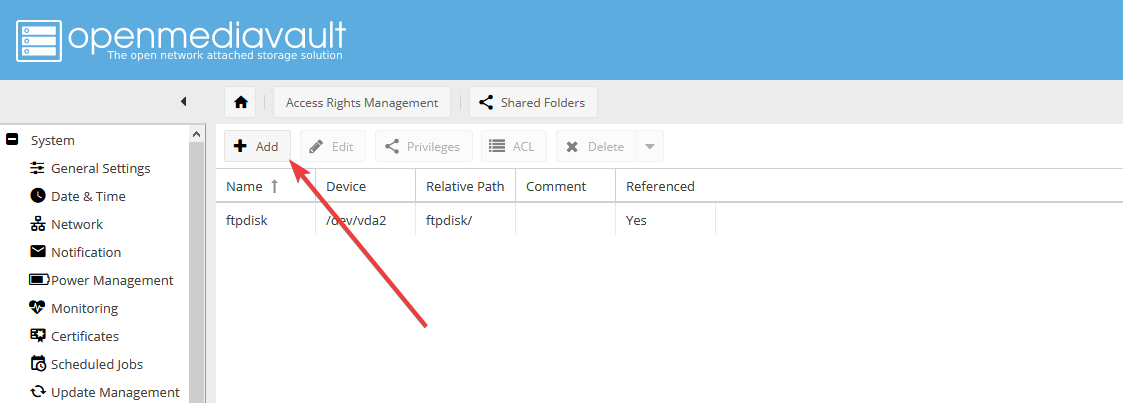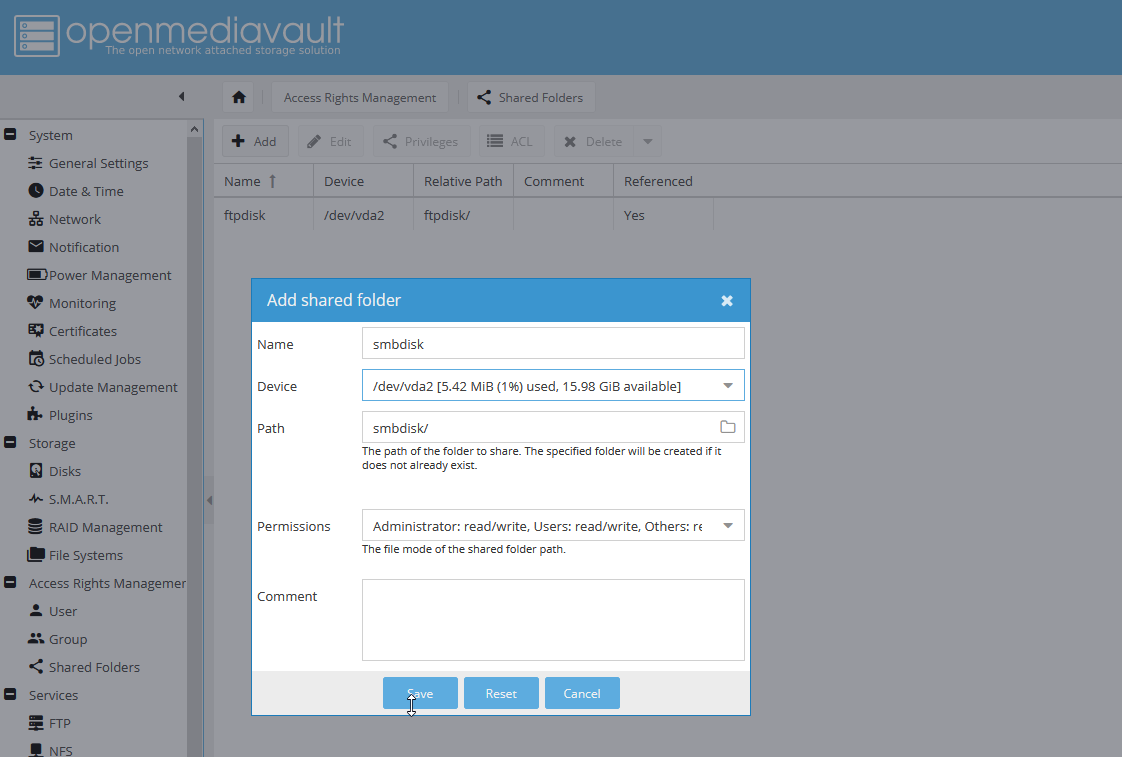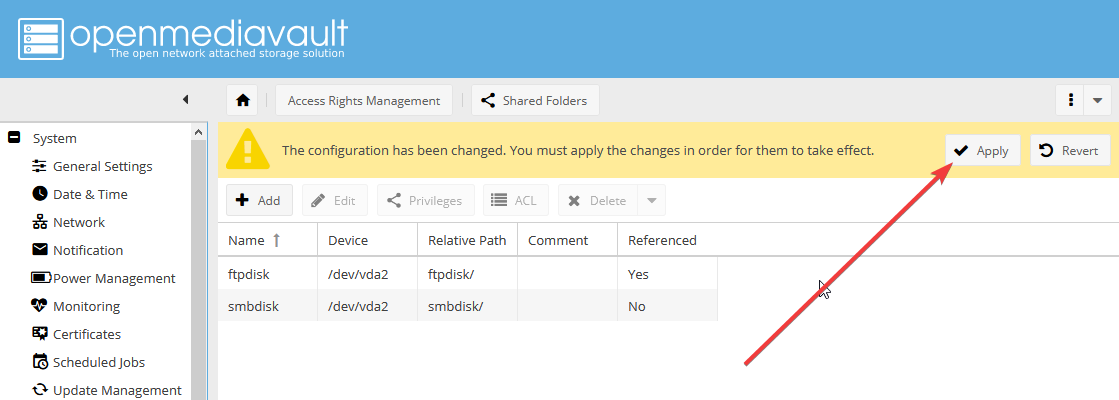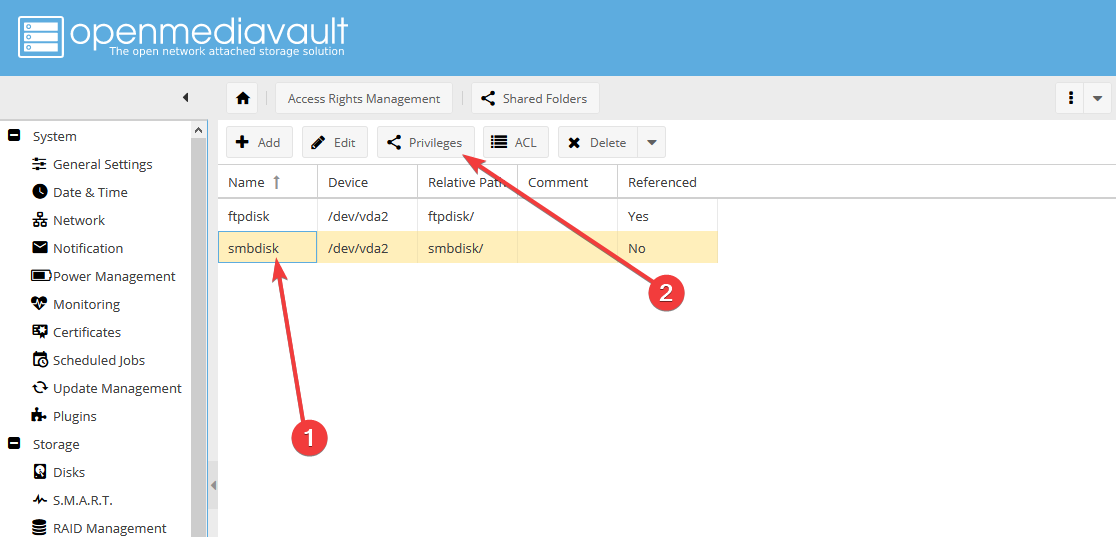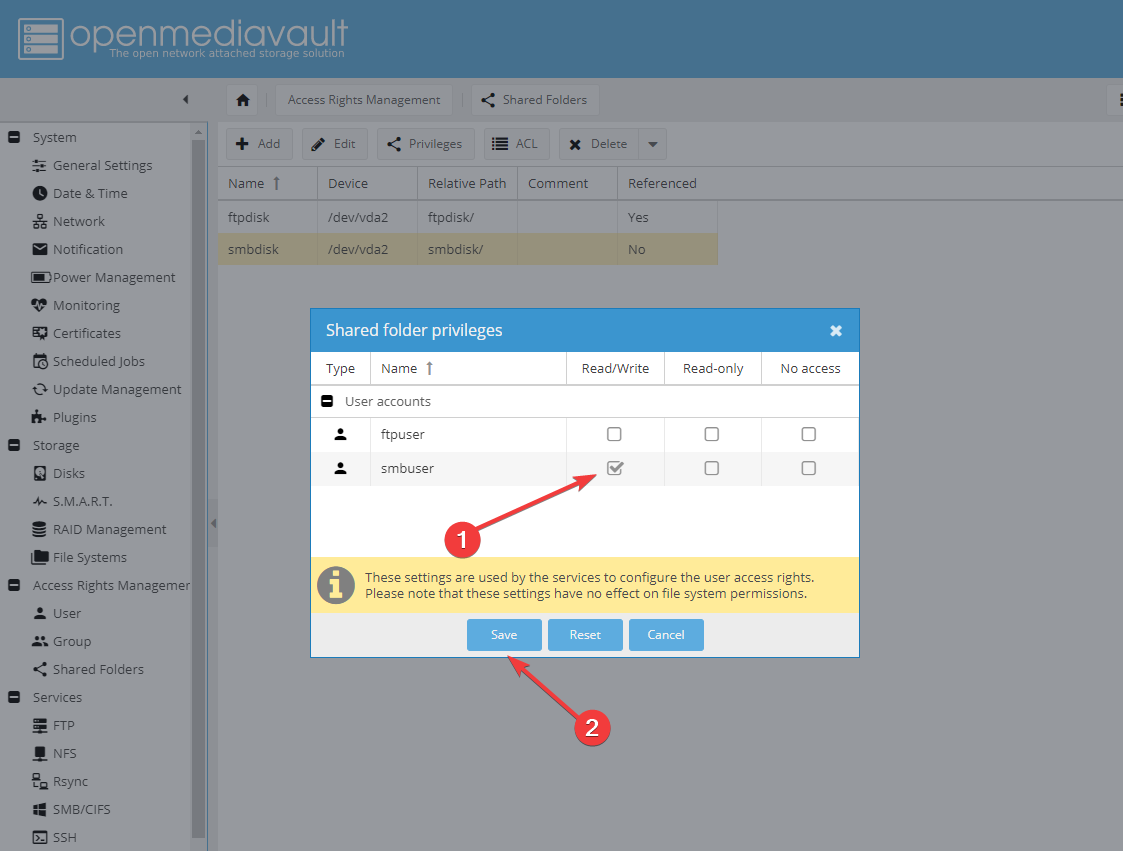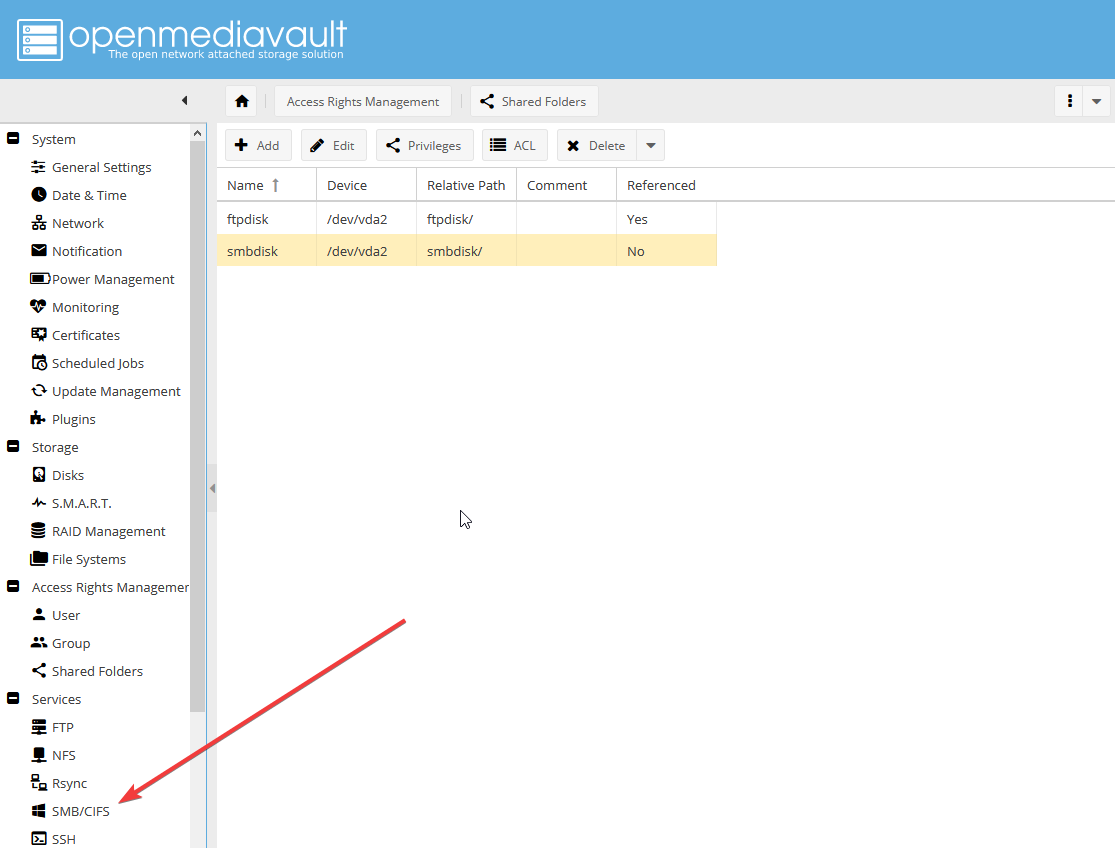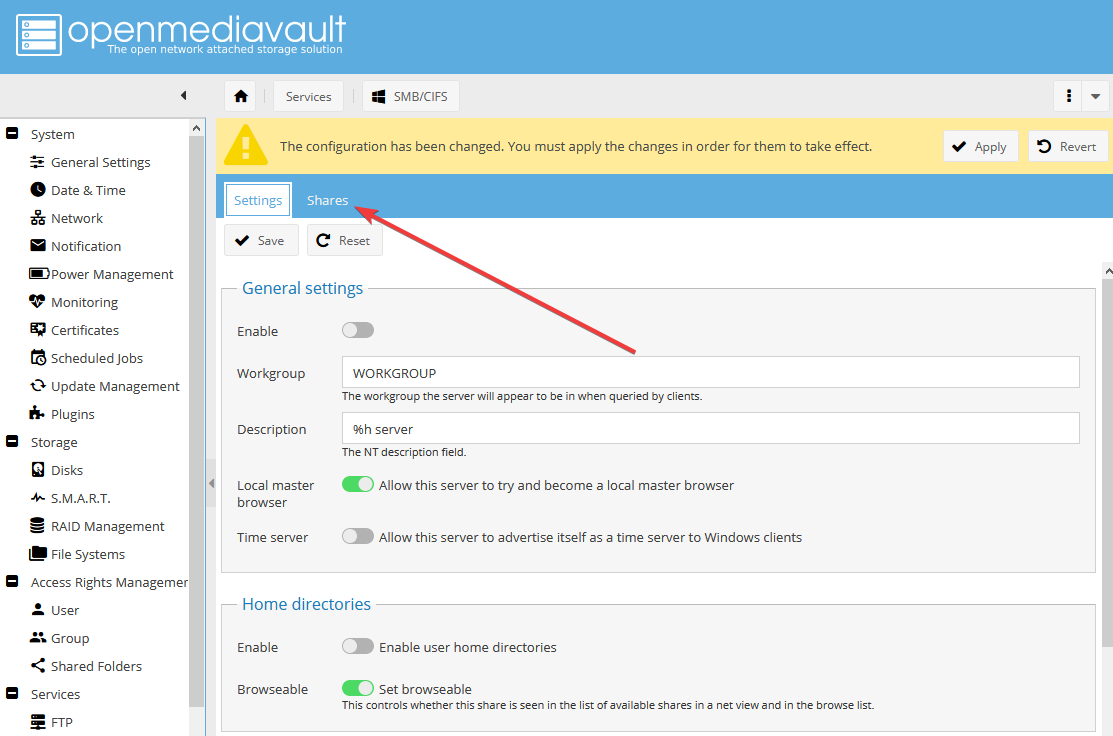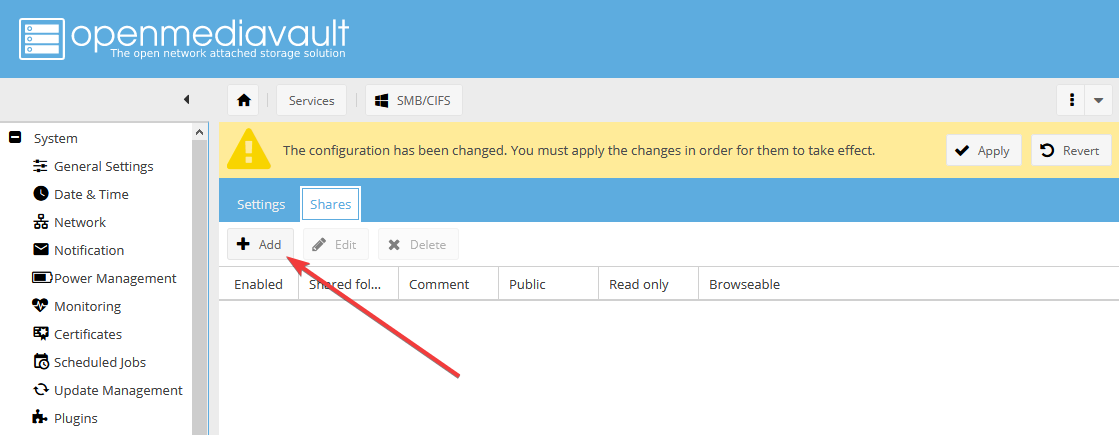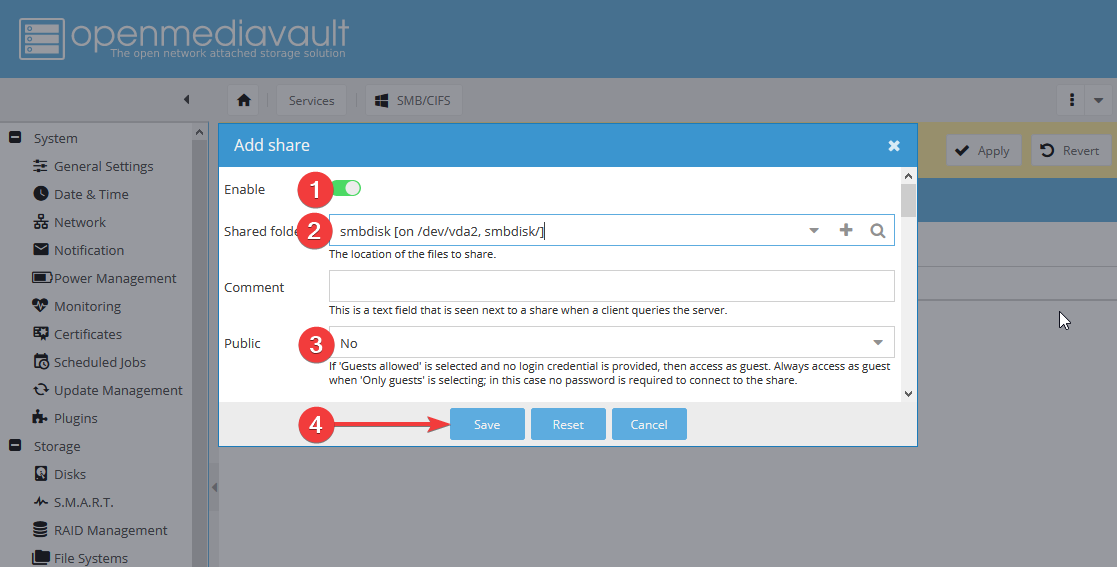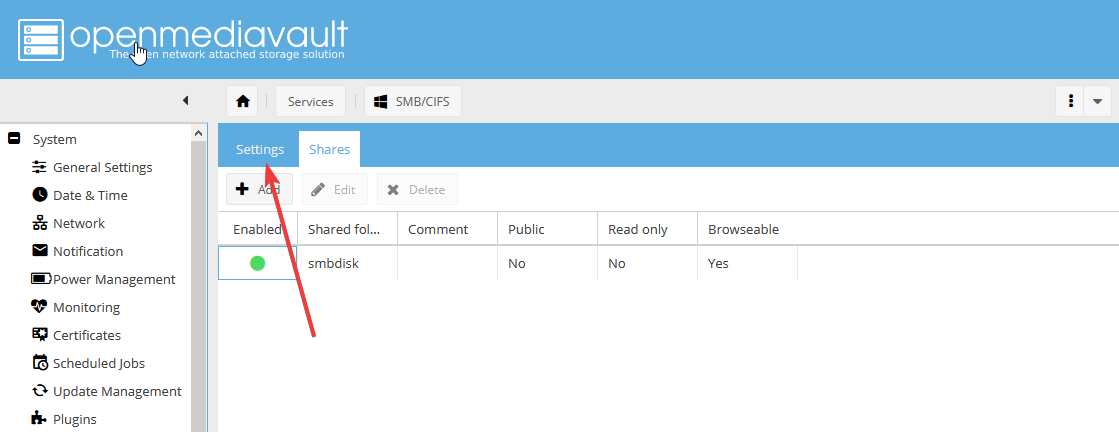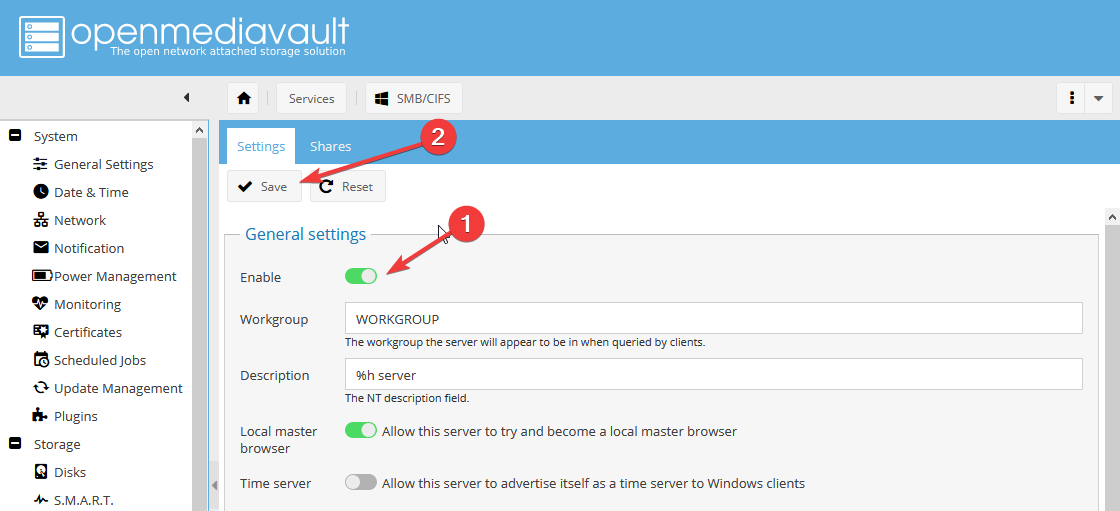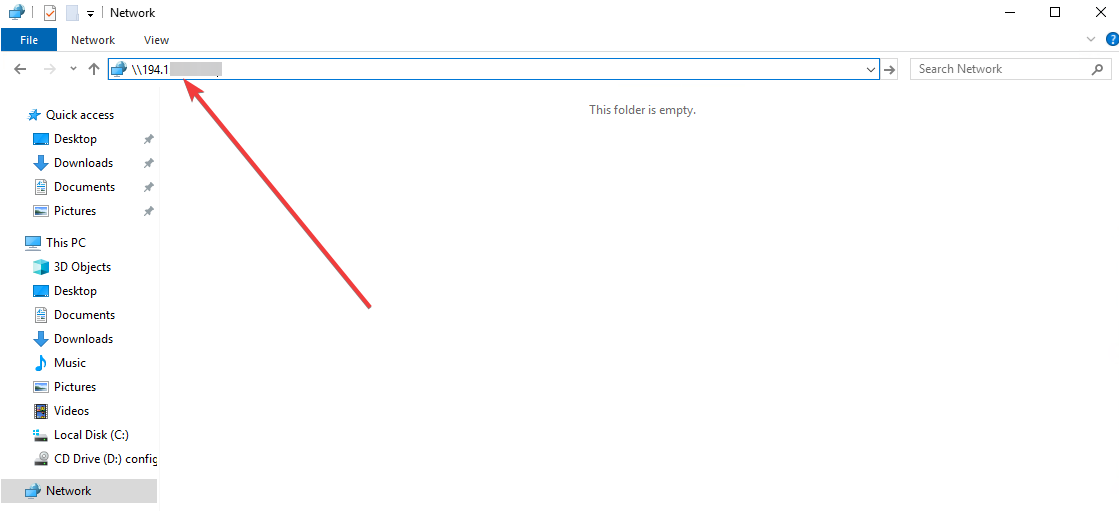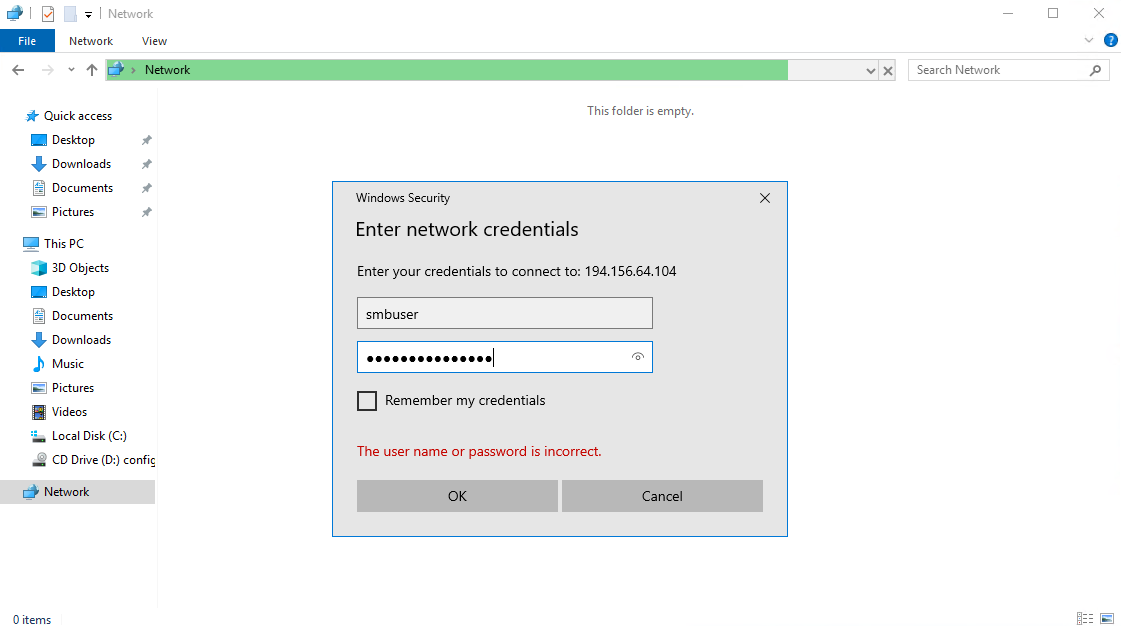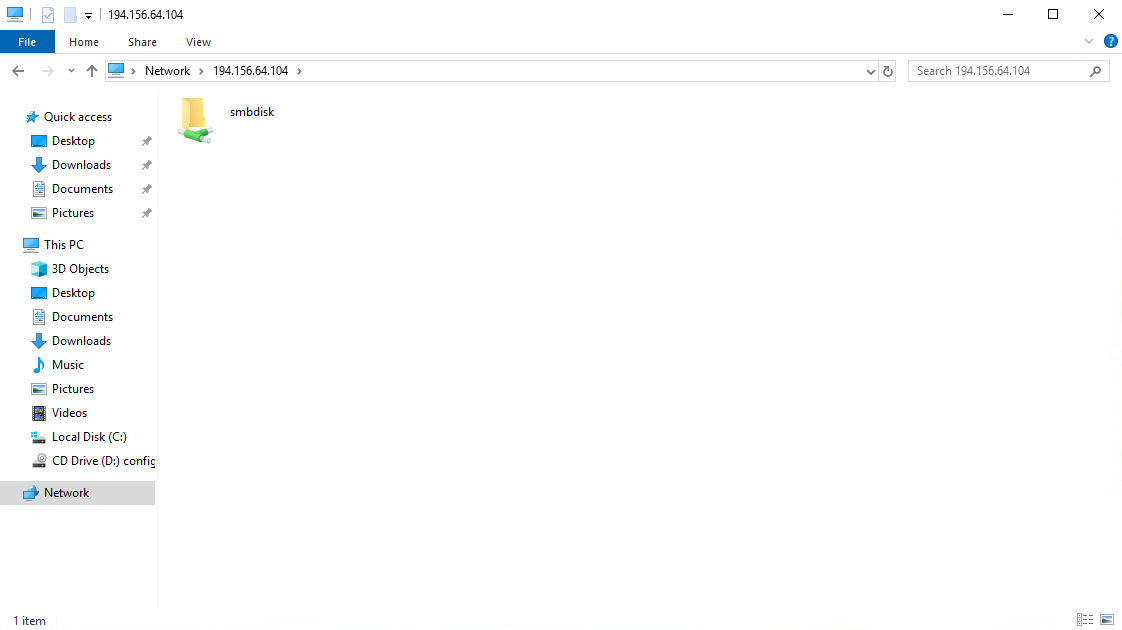Description
With this guide you are able to join a Windows domain (Either a Windows domain controller, either a Samba 4 domain controller) with your OpenMediaVault server.
This is a new method to join a domain with sssd instead of Winbind. It is much more easy to setup, and is more reliable than winbind.
However there is a drawback: if SSSD chooses himself UID and GID, the numbers seems to high to be available in OMV’s UI. If the Directory provides UID and GID set by the administrator, and low enough (10000 for example), OMV is able to show them.
This is currently a BETA, I successfully configured a fresh install of OMV 3 with these steps.
Requirements
- OpenMediaVault 3.0.83 or higher
- A Samba 4 domain controller with uid and gid properties set for users and groups
OMV Configuration
Network settings
- Check IP configuration
Use the web UI to setup a fixed IP address, and a hostname with a domain name matching your domain.
Open a terminal (locally ot with SSH) and check the hostname configuration of your OpenMediaVault.
root@my-server:~# hostname -s
my-server
root@my-server:~# hostmane -d
domain.com
root@my-server:~# cat /etc/hostname
my-server
root@my-server:~# cat /etc/hosts
127.0.0.1 localhost
127.0.1.1 my-server.domain.com my-server
# The following lines are desirable for IPv6 capable hosts
::1 localhost ip6-localhost ip6-loopback
ff02::1 ip6-allnodes
ff02::2 ip6-allroutersAlles anzeigen
The first command allows you to check the server has the expected name. It may be whatever you want.
The second command checks the suffix of your hostname. It must match the domain name of your domain controller.
The third command checks that /etc/hostname matches your hostname. If it does not matches hostname -s, then update it.
Packages installation
Now install the requred packages to install and use SSSD.
root@my-server:~# apt-get install sssd realmd policykit-1 packagekit adcli
root@my-server:~# realm discover -v domain.com
root@my-server:~# realm -v join domain.com -U administrator --membership-software=adcliapt-get install sssd and required packages
realm discover checks you can find your domain controller
realm join .. well .. joins your domain. You need a specify the login of a administrator account, and the process will ask you its password. Some additional packages will be automatically installed.
SSSD is running, you need to stop and reset its cache to tweak it.
Configure SSSD
service sssd stop
sss_cache -E
rm /var/lib/sss/db/*Check /etc/sssd/sssd.conf and switch use_fully_qualified_names to False. This allows you to authenticate without specifying your domain.
Read the Mapping algorithm paragraph of SSSD to determine if you want ldap_id_mapping or not. Either reading this page: https://linux.die.net/man/5/sssd-ad or either by reading it from OMV terminal.
If you want to disable ID mapping and use POSIX attributes in your AD, change also ldap_id_mapping to False. Doing this requires you set up uid and gid for all your users and groups in your directory.
If you want to show your users in the OpenMediaVault web interface, you need to add at the bottonm of section [domain/domain.com] the parameter enumerate = True. However this is NOT recommended because it will slow down the server and generate network traffic with your domain controller. If you got a lot of users, you should consider keep its default value (False) and configure permissions with setfacl. The same issue occurs with Winbind, so it is useless to prefer Winbind to workaround this problem.
Customize override_homedir to set the path containing your users home directories. You will bind a subtree of a filesystem here in next steps. This means this subtree will be available in 2 paths in OMV’s filesystem.
Here is an example of /etc/sssd/sssd.conf
Code: /etc/sssd/sssd.conf
[sssd]
domains = domain.com
config_file_version = 2
services = nss, pam
[domain/domain.com]
ad_domain = domain.com
krb5_realm = DOMAIN.COM
realmd_tags = manages-system joined-with-samba
cache_credentials = True
id_provider = ad
krb5_store_password_if_offline = True
default_shell = /bin/bash
# Enable the following line to manage UID and GID
#ldap_id_mapping = False
use_fully_qualified_names = False
override_homedir = /home/domain.com/users/%u
# fallback_homedir is actually useless, but I prefer keep it,
# if I need to do something with override_homedir
fallback_homedir = /home/domain.com/users/%u
access_provider = ad
#enumerate = TrueAlles anzeigen
Restart SSSD.
The command realm also updates /etc/nsswitch to use sssd as a source. You do not need to update it yourself, but here is an example of what you should read in this file. Notice the word sss is added in some lines.
# /etc/nsswitch.conf
#
# Example configuration of GNU Name Service Switch functionality.
# If you have the `glibc-doc-reference' and `info' packages installed, try:
# `info libc "Name Service Switch"' for information about this file.
passwd: compat sss
group: compat sss
shadow: compat sss
hosts: files mdns4_minimal [NOTFOUND=return] dns mdns4
networks: files
protocols: db files
services: db files sss
ethers: db files
rpc: db files
netgroup: nis sssAlles anzeigen
Now sssd is up to date and running, try to find an existing user
getent passwd johndoe
johndoe:*:10000:10000:johndoe:/home/DOMAIN/johndoe:/bin/bashEnable mkhomedir
create the file /usr/share/pam-configs/my_mkhomedir with the following content:
Name: Activate mkhomedir
Default: yes
Priority: 900
Session-Type: Additional
Session:
required pam_mkhomedir.so umask=0077 skel=/etc/skelUmask argument for mkhomedir didn’t worked for me. pam_umask.so seems be a better option. Create the file /usr/share/pam-configs/umask with the following:
Name: Activate umask
Default: yes
Priority: 800
Session-Type: Additional
Session:
optional pam_umask.so umask=0077Run the command pam-auth-update, enable Activate mkhomedir and Activate umask.
Configure Home directories
In the OMV UI, open the users administration panel. Assuming you got at least one shared folder defined, choose the tab Settings and enable user home directories. Choose a device and set the path /users to store them. This path is important for the next step.
Find the mounted data volume you want to use for your home directories. In this example, this is the last line. The path after «on» will be re-used to bind mount the volume in /home/domain.com.
mount
( ... snip ... )
tmpfs on /etc/machine-id type tmpfs (ro,relatime,size=100844k,mode=755)
systemd-1 on /proc/sys/fs/binfmt_misc type autofs (rw,relatime,fd=23,pgrp=1,timeout=300,minproto=5,maxproto=5,direct,pipe_ino=9415)
debugfs on /sys/kernel/debug type debugfs (rw,relatime)
mqueue on /dev/mqueue type mqueue (rw,relatime)
hugetlbfs on /dev/hugepages type hugetlbfs (rw,relatime)
fusectl on /sys/fs/fuse/connections type fusectl (rw,relatime)
tmpfs on /tmp type tmpfs (rw,relatime)
rpc_pipefs on /run/rpc_pipefs type rpc_pipefs (rw,relatime)
binfmt_misc on /proc/sys/fs/binfmt_misc type binfmt_misc (rw,relatime)
/dev/sdb1 on /srv/dev-disk-by-id-scsi-0QEMU_QEMU_HARDDISK_drive-scsi1-part1 type ext4 (rw,noexec,relatime,data=ordered,jqfmt=vfsv0,usrjquota=aquota.user,grpjquota=aquota.group)Alles anzeigen
Edit /etc/fstab and bind mount your share to /home/domain.com. The line must be added after # <<< [openmediavault]. This is ensures it will not be overwritten when you edit OpenMediaVault’s configuration.
/srv/dev-disk-by-id-scsi-0QEMU_QEMU_HARDDISK_drive-scsi1-part1 /home/domain.com none bind 0 2Go in SMB/CIFS configuration, and enable SMB/CIFS.
Set the Workgroup field to DOMAIN (uppercase, and match the word before the first dot of your domain name). Enable user home directories, and add the following on your extra options:
password server = *
realm = DOMAIN.COM
dedicated keytab file = FILE:/etc/krb5.keytab
kerberos method = dedicated keytab
security = ads
allow trusted domains = yes
template shell = /bin/bash
template homedir = /home/domain.com/users/%U
# Performance improvements
socket options = TCP_NODELAY SO_RCVBUF=8192 SO_SNDBUF=8192
client ntlmv2 auth = yes
client use spnego = yes
obey pam restrictions = yesAlles anzeigen
If you’re using OMV 4.X change the line
dedicated keytab file = FILE:/etc/krb5.keytab
into
dedicated keytab file = /etc/krb5.keytab
Save and apply changes.
Read this post if you’re under windows 8 to try a performance enhancement : http://forums.openmediavault.o…f=3&t=1493&p=24413#p24366
This step is not required
If you wish to view your AD users and groups in OMV webinterface include UIDs and GIDs into non-system users and groups in /etc/login.defs. Find UID_MAX and change UID_MAX and GID_MAX. You need to choose a value higher than the highest UID and GID you can find in your directory. Here are the default values.
UID_MAX 60000
GID_MAX 60000Editing AD users and groups using the OMV webinterface will fail because they are not stored in /etc/passwd and /etc/group .
You should now be able to browse your home dir and shares if any with a user managed by your Directory server, from a workstation enrolled with SSSD. To setup SSSD on a workstation, do the same as this guide, and don’t setup Samba (because it will probably not share files itself, thanks to OMV).
0
1
Всем привет. Возникла тут проблема с вводом FS на OpenMediaVault 5 в домен Active-directory. Я настраивал по этому руководству. К сожалению для 5-го не нашел. Но после сохранения настроек я не вижу списка доменных пользователей в OMV, и не могу распределять права на общие папки. Что самое интересное, машина в домене и комманда id "username" нормально отвечает:
# id vasya
uid=635601109(vasya) gid=635600513(пользователи домена) groups=635600513(пользователи домена),635600512(администраторы домена),635600572(группа с запрещением репликации паролей rodc)
и getent тоже всё видит.
getent passwd mahsa
mahsa:*:635601108:635600513:Mahsa:/home/mahsa@test.ts:/bin/bash
все настройки точно выполнил кроме создания домашних папок, мне это не нужно, только авторизация для CIFS..
Подскажите в чем проблема кто знает. Раньше года 3-4 назад настраивал правда через winbind, но тогда и версии были другие, Debian 7, ф сейчас уже 10.7.
Ниже приведены листинги файлов конфигурации.
sss
cat /etc/sssd/sssd.conf
[sssd]
domains = test.ts
config_file_version = 2
services = nss, pam
[domain/test.ts]
ad_domain = test.ts
ad_server = 1ctest.test.ts.
chpass_provider = ad
access_provider = simple
krb5_realm = TEST.TS
realmd_tags = manages-system joined-with-adcli
cache_credentials = True
id_provider = ad
krb5_store_password_if_offline = True
default_shell = /bin/bash
ldap_id_mapping = True
use_fully_qualified_names = False
fallback_homedir = /home/%u@%d
access_provider = ad
SAMBA 4.9.5-Debian Конфиг папки не стал вставлять.
testparm -v
rlimit_max: increasing rlimit_max (1024) to minimum Windows limit (16384)
Registered MSG_REQ_POOL_USAGE
Registered MSG_REQ_DMALLOC_MARK and LOG_CHANGED
Load smb config files from /etc/samba/smb.conf
rlimit_max: increasing rlimit_max (1024) to minimum Windows limit (16384)
Processing section "[test]"
Loaded services file OK.
WARNING: socket options = TCP_NODELAY SO_RCVBUF=8192 SO_SNDBUF=8192
This warning is printed because you set one of the
following options: SO_SNDBUF, SO_RCVBUF, SO_SNDLOWAT,
SO_RCVLOWAT
Modern server operating systems are tuned for
high network performance in the majority of situations;
when you set 'socket options' you are overriding those
settings.
Linux in particular has an auto-tuning mechanism for
buffer sizes (SO_SNDBUF, SO_RCVBUF) that will be
disabled if you specify a socket buffer size. This can
potentially cripple your TCP/IP stack.
Getting the 'socket options' correct can make a big
difference to your performance, but getting them wrong
can degrade it by just as much. As with any other low
level setting, if you must make changes to it, make
small changes and test the effect before making any
large changes.
Server role: ROLE_STANDALONE
Press enter to see a dump of your service definitions
# Global parameters
[global]
abort shutdown script =
add group script =
add machine script =
addport command =
addprinter command =
add share command =
add user script =
add user to group script =
afs token lifetime = 604800
afs username map =
aio max threads = 100
algorithmic rid base = 1000
allow dcerpc auth level connect = No
allow dns updates = secure only
allow insecure wide links = No
allow nt4 crypto = No
allow trusted domains = Yes
allow unsafe cluster upgrade = No
apply group policies = No
async smb echo handler = No
auth event notification = No
auto services =
binddns dir = /var/lib/samba/bind-dns
bind interfaces only = No
browse list = Yes
cache directory = /var/cache/samba
change notify = Yes
change share command =
check password script =
cldap port = 389
client ipc max protocol = default
client ipc min protocol = default
client ipc signing = default
client lanman auth = No
client ldap sasl wrapping = sign
client max protocol = default
client min protocol = CORE
client NTLMv2 auth = Yes
client plaintext auth = No
client schannel = Yes
client signing = default
client use spnego principal = No
client use spnego = Yes
cluster addresses =
clustering = No
config backend = file
config file =
create krb5 conf = Yes
ctdbd socket =
ctdb locktime warn threshold = 0
ctdb timeout = 0
cups connection timeout = 30
cups encrypt = No
cups server =
dcerpc endpoint servers = epmapper, wkssvc, rpcecho, samr, netlogon, lsarpc, drsuapi, dssetup, unixinfo, browser, eventlog6, backupkey, dnsserver
deadtime = 0
debug class = No
debug hires timestamp = Yes
debug pid = No
debug prefix timestamp = No
debug uid = No
dedicated keytab file =
default service =
defer sharing violations = Yes
delete group script =
deleteprinter command =
delete share command =
delete user from group script =
delete user script =
dgram port = 138
disable netbios = No
disable spoolss = Yes
dns forwarder =
dns proxy = No
dns update command = /usr/sbin/samba_dnsupdate
dns zone scavenging = No
domain logons = No
domain master = Auto
dos charset = CP850
dsdb event notification = No
dsdb group change notification = No
dsdb password event notification = No
enable asu support = No
enable core files = Yes
enable privileges = Yes
encrypt passwords = Yes
enhanced browsing = Yes
enumports command =
eventlog list =
get quota command =
getwd cache = Yes
gpo update command = /usr/sbin/samba-gpupdate
guest account = nobody
homedir map = auto.home
host msdfs = Yes
hostname lookups = No
idmap backend = tdb
idmap cache time = 604800
idmap gid =
idmap negative cache time = 120
idmap uid =
include system krb5 conf = Yes
init logon delay = 100
init logon delayed hosts =
interfaces =
iprint server =
keepalive = 300
kerberos encryption types = all
kerberos method = default
kernel change notify = Yes
kpasswd port = 464
krb5 port = 88
lanman auth = No
large readwrite = Yes
ldap admin dn =
ldap connection timeout = 2
ldap debug level = 0
ldap debug threshold = 10
ldap delete dn = No
ldap deref = auto
ldap follow referral = Auto
ldap group suffix =
ldap idmap suffix =
ldap machine suffix =
ldap page size = 1000
ldap passwd sync = no
ldap replication sleep = 1000
ldap server require strong auth = Yes
ldap ssl = start tls
ldap ssl ads = No
ldap suffix =
ldap timeout = 15
ldap user suffix =
lm announce = Auto
lm interval = 60
load printers = No
local master = Yes
lock directory = /var/run/samba
lock spin time = 200
log file = /var/log/samba/log.%m
logging = syslog
log level = 2
log nt token command =
logon drive =
logon home = \\%N\%U
logon path = \\%N\%U\profile
logon script =
log writeable files on exit = No
lpq cache time = 30
lsa over netlogon = No
machine password timeout = 604800
mangle prefix = 1
mangling method = hash2
map to guest = Bad User
max disk size = 0
max log size = 1000
max mux = 50
max open files = 16384
max smbd processes = 0
max stat cache size = 256
max ttl = 259200
max wins ttl = 518400
max xmit = 16644
mdns name = netbios
message command =
min receivefile size = 0
min wins ttl = 21600
mit kdc command =
multicast dns register = No
name cache timeout = 660
name resolve order = lmhosts wins host bcast
nbt client socket address = 0.0.0.0
nbt port = 137
ncalrpc dir = /var/run/samba/ncalrpc
netbios aliases =
netbios name = OMV
netbios scope =
neutralize nt4 emulation = No
NIS homedir = No
nmbd bind explicit broadcast = Yes
nsupdate command = /usr/bin/nsupdate -g
ntlm auth = ntlmv2-only
nt pipe support = Yes
ntp signd socket directory = /var/lib/samba/ntp_signd
nt status support = Yes
null passwords = No
obey pam restrictions = Yes
old password allowed period = 60
oplock break wait time = 0
os2 driver map =
os level = 20
pam password change = Yes
panic action = /usr/share/samba/panic-action %d
passdb backend = tdbsam
passdb expand explicit = No
passwd chat = *Enter\snew\s*\spassword:* %n\n *Retype\snew\s*\spassword:* %n\n *password\supdated\ssuccessfully* .
passwd chat debug = No
passwd chat timeout = 2
passwd program = /usr/bin/passwd %u
password hash gpg key ids =
password hash userPassword schemes =
password server = *
perfcount module =
pid directory = /var/run/samba
preferred master = Auto
prefork children = 1
preload modules =
printcap cache time = 750
printcap name = /dev/null
private dir = /var/lib/samba/private
raw NTLMv2 auth = No
read raw = Yes
realm =
registry shares = No
reject md5 clients = No
reject md5 servers = No
remote announce =
remote browse sync =
rename user script =
require strong key = Yes
reset on zero vc = No
restrict anonymous = 0
rndc command = /usr/sbin/rndc
root directory =
rpc big endian = No
rpc server dynamic port range = 49152-65535
rpc server port = 0
samba kcc command = /usr/sbin/samba_kcc
security = AUTO
server max protocol = SMB3
server min protocol = LANMAN1
server multi channel support = No
server role = auto
server schannel = Yes
server services = s3fs, rpc, nbt, wrepl, ldap, cldap, kdc, drepl, winbindd, ntp_signd, kcc, dnsupdate, dns
server signing = default
server string = %h server
set primary group script =
set quota command =
share backend = classic
show add printer wizard = Yes
shutdown script =
smb2 leases = Yes
smb2 max credits = 8192
smb2 max read = 8388608
smb2 max trans = 8388608
smb2 max write = 8388608
smbd profiling level = off
smb passwd file = /etc/samba/smbpasswd
smb ports = 445 139
socket options = TCP_NODELAY SO_RCVBUF=8192 SO_SNDBUF=8192
spn update command = /usr/sbin/samba_spnupdate
stat cache = Yes
state directory = /var/lib/samba
svcctl list =
syslog = 1
syslog only = No
template homedir = /home/domain.com/users/%U
template shell = /bin/bash
time server = No
timestamp logs = Yes
tls cafile = tls/ca.pem
tls certfile = tls/cert.pem
tls crlfile =
tls dh params file =
tls enabled = Yes
tls keyfile = tls/key.pem
tls priority = NORMAL:-VERS-SSL3.0
tls verify peer = as_strict_as_possible
unicode = Yes
unix charset = UTF-8
unix extensions = Yes
unix password sync = No
use mmap = Yes
username level = 0
username map =
username map cache time = 0
username map script =
usershare allow guests = No
usershare max shares = 100
usershare owner only = Yes
usershare path = /var/lib/samba/usershares
usershare prefix allow list =
usershare prefix deny list =
usershare template share =
utmp = No
utmp directory =
web port = 901
winbind cache time = 300
winbindd socket directory = /var/run/samba/winbindd
winbind enum groups = No
winbind enum users = No
winbind expand groups = 0
winbind max clients = 200
winbind max domain connections = 1
winbind nested groups = Yes
winbind normalize names = No
winbind nss info = template
winbind offline logon = No
winbind reconnect delay = 30
winbind refresh tickets = No
winbind request timeout = 60
winbind rpc only = No
winbind scan trusted domains = Yes
winbind sealed pipes = Yes
winbind separator = \
winbind use default domain = No
wins hook =
wins proxy = No
wins server =
wins support = No
workgroup = TEST
write raw = Yes
wtmp directory =
fruit:aapl = yes
idmap config * : backend = tdb
access based share enum = No
acl allow execute always = No
acl check permissions = Yes
acl group control = No
acl map full control = Yes
administrative share = No
admin users =
afs share = No
aio read size = 16384
aio write behind =
aio write size = 16384
allocation roundup size = 1048576
available = Yes
blocking locks = Yes
block size = 1024
browseable = Yes
case sensitive = Auto
check parent directory delete on close = No
comment =
copy =
create mask = 0777
csc policy = manual
cups options =
default case = lower
default devmode = Yes
delete readonly = No
delete veto files = No
dfree cache time = 0
dfree command =
directory mask = 0777
directory name cache size = 100
dmapi support = No
dont descend =
dos filemode = No
dos filetime resolution = No
dos filetimes = Yes
durable handles = Yes
ea support = Yes
fake directory create times = No
fake oplocks = No
follow symlinks = Yes
force create mode = 0000
force directory mode = 0000
force group =
force printername = No
force unknown acl user = No
force user =
fstype = NTFS
guest ok = No
guest only = No
hide dot files = Yes
hide files =
hide special files = No
hide unreadable = No
hide unwriteable files = No
hosts allow =
hosts deny =
include =
inherit acls = No
inherit owner = no
inherit permissions = No
invalid users =
kernel oplocks = No
kernel share modes = Yes
level2 oplocks = Yes
locking = Yes
lppause command =
lpq command = %p
lpresume command =
lprm command =
magic output =
magic script =
mangled names = yes
mangling char = ~
map acl inherit = No
map archive = Yes
map hidden = No
map readonly = no
map system = No
max connections = 0
max print jobs = 1000
max reported print jobs = 0
min print space = 0
msdfs proxy =
msdfs root = No
msdfs shuffle referrals = No
nt acl support = Yes
ntvfs handler = unixuid, default
oplocks = Yes
path =
posix locking = Yes
postexec =
preexec =
preexec close = No
preserve case = Yes
printable = No
print command =
printer name =
printing = bsd
printjob username = %U
print notify backchannel = No
queuepause command =
queueresume command =
read list =
read only = Yes
root postexec =
root preexec =
root preexec close = No
short preserve case = Yes
smb encrypt = default
spotlight = No
store dos attributes = Yes
strict allocate = No
strict locking = Auto
strict rename = No
strict sync = Yes
sync always = No
use client driver = No
use sendfile = Yes
valid users =
veto files =
veto oplock files =
vfs objects =
volume =
wide links = No
write cache size = 0
write list =
nsswitch
cat /etc/nsswitch.conf
# /etc/nsswitch.conf
#
# Example configuration of GNU Name Service Switch functionality.
# If you have the `glibc-doc-reference' and `info' packages installed, try:
# `info libc "Name Service Switch"' for information about this file.
passwd: files systemd sss
group: files systemd sss
shadow: files sss
gshadow: files
hosts: files mdns4_minimal [NOTFOUND=return] dns myhostname
networks: files
protocols: db files
services: db files sss
ethers: db files
rpc: db files
netgroup: nis sss
Microsoft NT Domain / Active Directory provides for single sign-on, time sync, roaming user profiles and other features.
From home use of NAS appliances single sign on is the immediately seen problem. Creating new user or changing password should be repeated on every single device. Fragile and boring.
Microsoft desktop operating systems are prohibited from becoming «domain controllers».
However SAMBA has domain controller functionality. It is limited (for example Russian AstraLinux FAQ says once domain was created in Samba it can not be renamed, only deleted and created anew) and might be obsolete, but it would be enough at least for having centralized users database for all the family.
https://wiki.samba.org/index.php/Setting_up_Samba_as_an_Active_Directory_Domain_Controller
Протокол Server Message Block (SMB — Samba) позволяет объединять в сети и обмениваться файлами между компьютерами с несовместимыми операционными системами Windows и UNIX/Linux. С помощью Samba можно адаптировать для ОС Windows распространенные сетевые решения. Например, создать на удаленном сервере сетевое хранилище (SAMBA-диск) для Windows на основе решения OpenMediaVault.
Мы расскажем, как это сделать на сервере с предустановленным решением OpenMediaVault (OMV).
- После заказа сервера OMV вам на почту придет активационное письмо с данными доступа: IP, логин и пароль
Подключитесь к веб-панели по указанному в письме адресу http://<ip> и авторизуйтесь, указав логин и пароль - Создадим нового пользователя c именем smbuser
Нажмите на кнопку Add (добавить нового пользователя) и заполните открывшуюся форму (логин, пароль и подтверждение пароля). После этого подтвердите изменения.
- В панели откройте вкладку shared folders:
- Создайте новую shared folders:
- Заполните форму по созданию shared folder, указав название, выбрав диск. Остальные опции оставьте по умолчанию и нажмите Save.
Подтвердите изменения:
- Далее нужно настроить доступ для чтения и записи для пользователя smbuser: выделите shared folder smbdisk (1) и нажмите Privileges (2):
В открывшемся окне поставьте галочку напротив Read/Write для пользователя smbuser (1) и нажмите Save (2):
Окно закроется и останется подтвердить изменения.
- В боковом меню выберите Services > SMB/CIFS:
Откройте вкладку Shares:
Нажмите кнопку Add, чтоб «привязать» новую shared folder к службе SMB:
Заполните форму следующим образом: включите Share (1), выберите в поле Shared Folder созданную папку smbdisk (2), укажите в поле Public значение None (3)и нажмите Save (4):
Подтвердите изменения.
- Вернитесь во вкладку Settings:
Включите службу SMB (1) и нажмите Save (2):
Подтвердите изменения.
- После этого откройте на компьютере Windows папку Сеть (Network) и в адресной строке введите \\ip-address (ip-адрес Вашего сервера).
- После этого откроется диалоговое окно для подключения к диску:
Введите логин smbuser и пароль, который вы указали в п.2 и нажмите ок.После этого Вы получите доступ к SAMBA-диску:
Теперь вы можете пользоваться вашим новым сетевым диском.
Купите Openmediavault VPS прямо сейчас
Минимальная конфигурация включает:
1 ядро, 2Gb RAM, 60Gb Жесткий диск
В каждый тариф входят 5 Тб ежемесячного трафика и выделенный IP адрес.
Вы можете изменять параметры тарифов и подобрать индивидуальную конфигурацию.
google translate français italiano español 中国 한국의 Azərbaycan Deutsch Polskie 日本人 O’zbekiston Қазақстан
_____________________________________________________________________
Здравствуйте наконец дошли руки написать как я добавил сетевое хранилище к домену.
ТЗ: В организованной доменной сети добавить сетевую папку с соответствующими правами для группы пользователей.
ТО: Настроена доменная сеть. Машина на плате со встроенным процессором 1.2 ггц, 8 гб оперативной памяти, 1 ssd диск 32 гб, 2 hdd диска 2 тб каждый.
_____________________________________________________________________
Решение:
1. Скачиваю установочный образ будущей NAS с сайта:
http://sourceforge.net/projects/openmediavault/files/2.1/
openmediavault_2.1_amd64.iso
2. Устанавливаю Openmediavault 2.1 и настраиваю через веб интерфейс сеть, время, оповещения на почту, создаю папку «share_1», включаю SMB сервис добавляю папку, включаю ssh сервис для удаленного доступа (если вы не созавали пользователя, то стоит разрешить на время root пользователя в SSH).
3. Для доступа по SSH пользуюсь программой PUTTY с сайта:
http://www.chiark.greenend.org.uk/~sgtatham/putty/download.html
A Windows installer for everything except PuTTYtel
Installer: putty-0.65-installer.exe
4. Подключившись к консоли Openmediavault 2.1 устанавливаю PBIS для подключения к домену. Можно скачать по адресу : http://download1.beyondtrust.com/Technical-Support/Downloads/PowerBroker-Identity-Services-Open-Edition/?Pass=True
wget http://download.beyondtrust.com/PBISO/8.3/pbis-open-8.3.0.3287.linux.x86_64.deb.sh
chmod 777 pbis-open-8.3.0.3287.linux.x86_64.deb.sh
./pbis-open-8.3.0.3287.linux.x86_64.deb.sh
/opt/pbis/bin/domainjoin-cli join domainName ADjoinAccount
DOMAIN\\username
…
Настраивал по статье: http://habrahabr.ru/post/174407/
На контроллере домена Zentyal 4.1 проверим и если нет то допишем соответствующую запись DNS с адресом и именем. Если требуется доступ по впн то установим OpenVPN клиент и скопирем файлы конфигурации.
5. Ещё я добавил вот это:
/opt/pbis/bin/samba-interop-install --install --loglevel debug
nano /etc/samba/smb.conf
тут строчки новые:
[global]
security = ADS
workgroup = MYDOMEN
realm = MYDOMEN.RU
machine password timeout = 0
сохраняем ctrl+x
/etc/init.d/samba restart script
Делал по статье: http://habrahabr.ru/post/174497/
6. Всё в принципе готово, можно порпробовать подключится пользователями из разных групп, чтобы проверить права доступа. Если все хорошо то запрос логин/пароль должен отсутствовать, а со сторонних машин должен присутствовать.
7. Дальнейшие настройки и назначение прав ACL осуществляется СТАНДАРТНО в веб интерфейсе OpenMediaVault 2.1
Спасибо за внимание.
_______________________________________
P.S. Пункт (8.) иногда после перезагрузки фаил /etc/samba/smb.conf возвращается в исходное состояние, если вы потеряли доступ из домена проверьте ещё раз наличие строк:
security = ADS
realm = MYDOMEN.RU
machine password timeout = 0
_______________________________________
Репозитарий:
Открытая версия:
wget -O - http://repo.pbis.beyondtrust.com/yum/RPM-GPG-KEY-pbis|sudo apt-key add -
sudo wget -O /etc/apt/sources.list.d/pbiso.list http://repo.pbis.beyondtrust.com/apt/pbiso.list
sudo apt-get update
sudo apt-get install pbis-open
Коммерческая версия:
wget -O - http://repo.pbis.beyondtrust.com/yum/RPM-GPG-KEY-pbis|sudo apt-key add -
sudo wget -O /etc/apt/sources.list.d/pbiso.list http://repo.pbis.beyondtrust.com/apt/pbise.list
sudo apt-get update
sudo apt-get install pbis-enterprise
Тоже самое для yum:
sudo wget -O /etc/yum.repos.d/pbiso.repo http://repo.pbis.beyondtrust.com/yum/pbiso.repo
sudo yum clean all
sudo yum install pbis-open
Коммерческая версия:
sudo wget -O /etc/yum.repos.d/pbise.repo http://repo.pbis.beyondtrust.com/yum/pbise.repo
sudo yum clean all
sudo yum install pbis-enterprise
Форум по этой теме: http://forum.beyondtrust.com/
ввод:
sudo domainjoin-cli join --disable ssh domain username
вывод:
sudo domainjoin-cli leave --disable ssh domain username
________________________________________________________________________________
Решение возможной ошибки ДНС для убунту http://askubuntu.com/questions/100661/adding-ubuntu-to-active-directory-with-likewise-open
или так:
создадим запись в днс на домене через виндовс и создадм запись на клиенте
sudo nano /etc/resolv.conf
добавляем
search domainmy.ru 192.168.1.2
пробуем
sudo domainjoin-cli join domainmy.ru Administrator
________________________________________________________________________________

